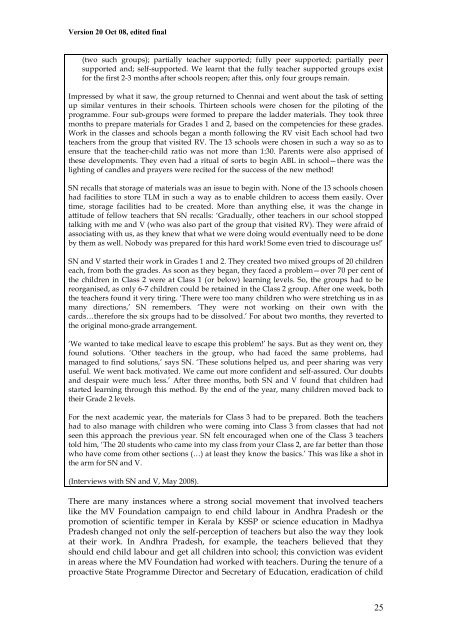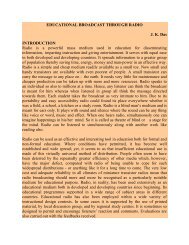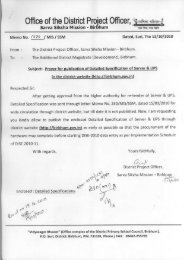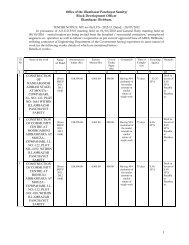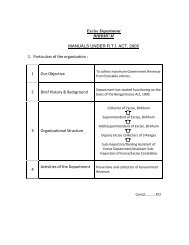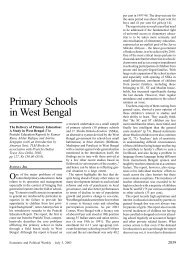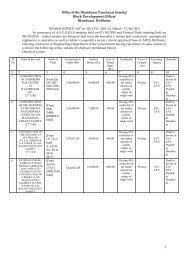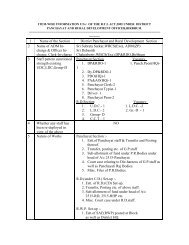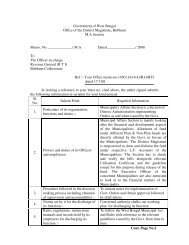Version 20 Oct 08, edited finalThus, despite years <strong>of</strong> government policy statements promoting education for all,<strong>school</strong> systems transmit exactly <strong>the</strong> opposite message. The words <strong>of</strong> <strong>teachers</strong>quoted above <strong>of</strong>fer damning evidence <strong>of</strong> <strong>the</strong> failure <strong>of</strong> <strong>school</strong> systems to put intopractice what educational policy so ardently preaches. Rhetoric apart, <strong>teachers</strong> dowhat <strong>the</strong>ir day-to-day pr<strong>of</strong>essional environment dem<strong>and</strong>s. The focus on rules ra<strong>the</strong>rthan outcomes, <strong>the</strong> treatment <strong>of</strong> <strong>teachers</strong> as <strong>the</strong> bottom rung <strong>of</strong> government servants<strong>and</strong> <strong>the</strong> absence <strong>of</strong> mechanisms for <strong>teachers</strong> to even discuss <strong>the</strong> reality <strong>of</strong> <strong>the</strong>irworking conditions, let alone develop solutions to local problems all contribute to<strong>the</strong> attitude among many <strong>teachers</strong> that learning outcomes are not <strong>the</strong>ir responsibility;<strong>and</strong> that if poor or disadvantaged students do not learn, it is because <strong>of</strong> <strong>the</strong>ir own or<strong>the</strong>ir family’s shortcomings.Current trends suggest that many states have started holding <strong>teachers</strong> responsiblefor learning outcomes. Yet, as we have seen, <strong>the</strong>y are given nei<strong>the</strong>r <strong>the</strong> tools nor<strong>the</strong> support necessary to do so successfully. This puts enormous pressure on<strong>teachers</strong> <strong>and</strong> at <strong>the</strong> same time <strong>the</strong> way <strong>the</strong> system treats <strong>the</strong>m ends up undermining<strong>the</strong>ir position in <strong>the</strong> <strong>school</strong>, <strong>the</strong>ir self-esteem <strong>and</strong> confidence.Some alternative modelsMany people engaged with education, especially with <strong>teachers</strong>, believe thatwherever <strong>teachers</strong> have <strong>the</strong> freedom to do things differently, when <strong>the</strong>y have <strong>the</strong>confidence to take decisions <strong>and</strong> when <strong>the</strong>y are provided an environment in which<strong>the</strong>y can actually break out <strong>of</strong> <strong>the</strong> mould that <strong>the</strong>y have been cast in <strong>the</strong>y do better,<strong>and</strong> more importantly, <strong>the</strong> children do better. 2 The first step to becoming anempowered teacher is to feel good about oneself <strong>and</strong> gain <strong>the</strong> confidence to reach outto knowledge <strong>and</strong> skills. They <strong>the</strong>n take pride in <strong>the</strong>ir work, take decisions in <strong>the</strong>irown sphere <strong>and</strong> finally become <strong>the</strong>ir own critics.For most <strong>teachers</strong> in <strong>the</strong> country, <strong>the</strong>se conditions do not exist. But <strong>the</strong>re are, onceagain, isl<strong>and</strong>s <strong>of</strong> hope. The Activity Based Learning (ABL) programme in TamilNadu provides one such example.Box 2.4: How <strong>the</strong> ABL process transformed a teacherSN was part <strong>of</strong> a group that visited Rishi Valley (RV) in September 2003. The group wasexpected to pilot <strong>the</strong> ABL approach in Chennai Corporation <strong>school</strong>s on its return. Theystayed in <strong>the</strong> RV project (satellite <strong>school</strong>s) for five days, keenly observed <strong>the</strong> RV method <strong>and</strong>learnt much from <strong>the</strong>ir interactions with <strong>teachers</strong> <strong>and</strong> children. SN recalls:- All children seemed to be engaged in learning—<strong>the</strong>y were really learning, <strong>and</strong> it was nota show put on to impress us!- There were only 30 children to a teacher, <strong>and</strong> not more. We liked this (…) both children<strong>and</strong> <strong>teachers</strong> were doing work. They were also doing whole class activities…- No textbooks were present. On <strong>the</strong> o<strong>the</strong>r h<strong>and</strong>, each child had individual learningmaterials.- The classroom not only had a blackboard for <strong>the</strong> teacher, but for <strong>the</strong> children as well, allalong <strong>the</strong> wall. We found children using <strong>the</strong>ir own blackboards quite frequently forvarious activities.- There were six sub-groups <strong>of</strong> children. The groups were fully supported by <strong>the</strong> teacher2 Interviews with Dr. Krishna Kumar, Subir Shukla, Pr<strong>of</strong>essor R. Govinda, Dr. Sharada Jain,Rohit Dhankar, Amuka Mahapatra, Krishnan Master <strong>and</strong> YAP Rao between February <strong>and</strong>July 200824
Version 20 Oct 08, edited final(two such groups); partially teacher supported; fully peer supported; partially peersupported <strong>and</strong>; self-supported. We learnt that <strong>the</strong> fully teacher supported groups existfor <strong>the</strong> first 2-3 months after <strong>school</strong>s reopen; after this, only four groups remain.Impressed by what it saw, <strong>the</strong> group returned to Chennai <strong>and</strong> went about <strong>the</strong> task <strong>of</strong> settingup similar ventures in <strong>the</strong>ir <strong>school</strong>s. Thirteen <strong>school</strong>s were chosen for <strong>the</strong> piloting <strong>of</strong> <strong>the</strong>programme. Four sub-groups were formed to prepare <strong>the</strong> ladder materials. They took threemonths to prepare materials for Grades 1 <strong>and</strong> 2, based on <strong>the</strong> competencies for <strong>the</strong>se grades.Work in <strong>the</strong> classes <strong>and</strong> <strong>school</strong>s began a month following <strong>the</strong> RV visit Each <strong>school</strong> had two<strong>teachers</strong> from <strong>the</strong> group that visited RV. The 13 <strong>school</strong>s were chosen in such a way so as toensure that <strong>the</strong> teacher-child ratio was not more than 1:30. Parents were also apprised <strong>of</strong><strong>the</strong>se developments. They even had a ritual <strong>of</strong> sorts to begin ABL in <strong>school</strong>—<strong>the</strong>re was <strong>the</strong>lighting <strong>of</strong> c<strong>and</strong>les <strong>and</strong> prayers were recited for <strong>the</strong> success <strong>of</strong> <strong>the</strong> new method!SN recalls that storage <strong>of</strong> materials was an issue to begin with. None <strong>of</strong> <strong>the</strong> 13 <strong>school</strong>s chosenhad facilities to store TLM in such a way as to enable children to access <strong>the</strong>m easily. Overtime, storage facilities had to be created. More than anything else, it was <strong>the</strong> change inattitude <strong>of</strong> fellow <strong>teachers</strong> that SN recalls: ‘Gradually, o<strong>the</strong>r <strong>teachers</strong> in our <strong>school</strong> stoppedtalking with me <strong>and</strong> V (who was also part <strong>of</strong> <strong>the</strong> group that visited RV). They were afraid <strong>of</strong>associating with us, as <strong>the</strong>y knew that what we were doing would eventually need to be doneby <strong>the</strong>m as well. Nobody was prepared for this hard work! Some even tried to discourage us!’SN <strong>and</strong> V started <strong>the</strong>ir work in Grades 1 <strong>and</strong> 2. They created two mixed groups <strong>of</strong> 20 childreneach, from both <strong>the</strong> grades. As soon as <strong>the</strong>y began, <strong>the</strong>y faced a problem—over 70 per cent <strong>of</strong><strong>the</strong> children in Class 2 were at Class 1 (or below) learning levels. So, <strong>the</strong> groups had to bereorganised, as only 6-7 children could be retained in <strong>the</strong> Class 2 group. After one week, both<strong>the</strong> <strong>teachers</strong> found it very tiring. ‘There were too many children who were stretching us in asmany directions,’ SN remembers. ‘They were not working on <strong>the</strong>ir own with <strong>the</strong>cards…<strong>the</strong>refore <strong>the</strong> six groups had to be dissolved.’ For about two months, <strong>the</strong>y reverted to<strong>the</strong> original mono-grade arrangement.‘We wanted to take medical leave to escape this problem!’ he says. But as <strong>the</strong>y went on, <strong>the</strong>yfound solutions. ‘O<strong>the</strong>r <strong>teachers</strong> in <strong>the</strong> group, who had faced <strong>the</strong> same problems, hadmanaged to find solutions,’ says SN. ‘These solutions helped us, <strong>and</strong> peer sharing was veryuseful. We went back motivated. We came out more confident <strong>and</strong> self-assured. Our doubts<strong>and</strong> despair were much less.’ After three months, both SN <strong>and</strong> V found that children hadstarted learning through this method. By <strong>the</strong> end <strong>of</strong> <strong>the</strong> year, many children moved back to<strong>the</strong>ir Grade 2 levels.For <strong>the</strong> next academic year, <strong>the</strong> materials for Class 3 had to be prepared. Both <strong>the</strong> <strong>teachers</strong>had to also manage with children who were coming into Class 3 from classes that had notseen this approach <strong>the</strong> previous year. SN felt encouraged when one <strong>of</strong> <strong>the</strong> Class 3 <strong>teachers</strong>told him, ‘The 20 students who came into my class from your Class 2, are far better than thosewho have come from o<strong>the</strong>r sections (…) at least <strong>the</strong>y know <strong>the</strong> basics.’ This was like a shot in<strong>the</strong> arm for SN <strong>and</strong> V.(Interviews with SN <strong>and</strong> V, May 2008).There are many instances where a strong social movement that involved <strong>teachers</strong>like <strong>the</strong> MV Foundation campaign to end child labour in Andhra Pradesh or <strong>the</strong>promotion <strong>of</strong> scientific temper in Kerala by KSSP or science education in MadhyaPradesh changed not only <strong>the</strong> self-perception <strong>of</strong> <strong>teachers</strong> but also <strong>the</strong> way <strong>the</strong>y lookat <strong>the</strong>ir work. In Andhra Pradesh, for example, <strong>the</strong> <strong>teachers</strong> believed that <strong>the</strong>yshould end child labour <strong>and</strong> get all children into <strong>school</strong>; this conviction was evidentin areas where <strong>the</strong> MV Foundation had worked with <strong>teachers</strong>. During <strong>the</strong> tenure <strong>of</strong> aproactive State Programme Director <strong>and</strong> Secretary <strong>of</strong> Education, eradication <strong>of</strong> child25
- Page 5 and 6: Version 20 Oct 08, edited finalIWhy
- Page 7 and 8: Version 20 Oct 08, edited finalThis
- Page 9 and 10: Version 20 Oct 08, edited finalIISh
- Page 11 and 12: Version 20 Oct 08, edited finalwant
- Page 13 and 14: Version 20 Oct 08, edited finalWhy
- Page 15 and 16: Version 20 Oct 08, edited finalallo
- Page 17 and 18: Version 20 Oct 08, edited finalfor
- Page 19 and 20: Version 20 Oct 08, edited finalHeal
- Page 21 and 22: Version 20 Oct 08, edited finalcomm
- Page 23: Version 20 Oct 08, edited finalLet
- Page 27 and 28: Version 20 Oct 08, edited finalThe
- Page 29 and 30: Version 20 Oct 08, edited finalIIIW
- Page 31 and 32: Version 20 Oct 08, edited finalstat
- Page 33 and 34: Version 20 Oct 08, edited finalunde
- Page 35 and 36: Version 20 Oct 08, edited final- Th
- Page 37 and 38: Version 20 Oct 08, edited finalIVBe
- Page 39 and 40: Version 20 Oct 08, edited finalOver
- Page 41 and 42: Version 20 Oct 08, edited finallate
- Page 43 and 44: Version 20 Oct 08, edited finalNotw
- Page 45 and 46: Version 20 Oct 08, edited finalwas
- Page 47 and 48: Version 20 Oct 08, edited finalacco
- Page 49 and 50: Version 20 Oct 08, edited finalscho
- Page 51 and 52: Version 20 Oct 08, edited finalVTra
- Page 53 and 54: Version 20 Oct 08, edited finalques
- Page 55 and 56: Version 20 Oct 08, edited final1994
- Page 57 and 58: Version 20 Oct 08, edited finalimpr
- Page 59 and 60: Version 20 Oct 08, edited finalBox
- Page 61 and 62: Version 20 Oct 08, edited finaladmi
- Page 63 and 64: Version 20 Oct 08, edited finalTrai
- Page 65 and 66: Version 20 Oct 08, edited finalhelp
- Page 67 and 68: Version 20 Oct 08, edited final(Kin
- Page 69 and 70: Version 20 Oct 08, edited finalinst
- Page 71 and 72: Version 20 Oct 08, edited finalfund
- Page 73 and 74: Version 20 Oct 08, edited finalCrea
- Page 75 and 76:
Version 20 Oct 08, edited finalBIBL
- Page 77 and 78:
Version 20 Oct 08, edited finalDe,
- Page 79 and 80:
Version 20 Oct 08, edited finalGove
- Page 81 and 82:
Version 20 Oct 08, edited finalKuma
- Page 83 and 84:
Version 20 Oct 08, edited final____
- Page 85 and 86:
Version 20 Oct 08, edited finalSyno
- Page 87 and 88:
Version 20 Oct 08, edited finalSC:


